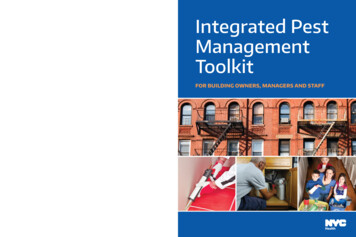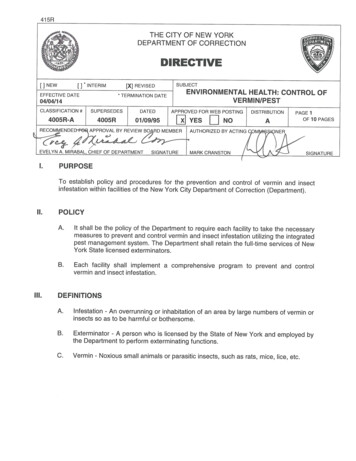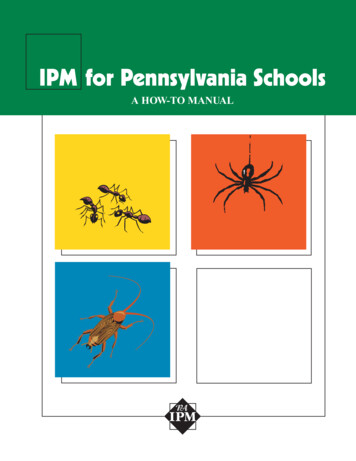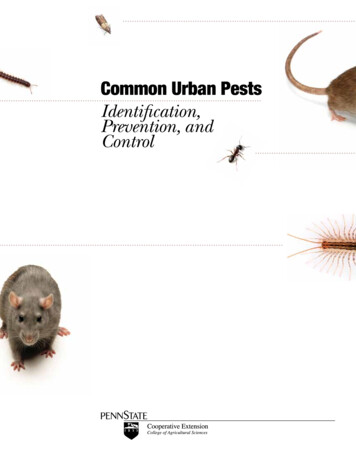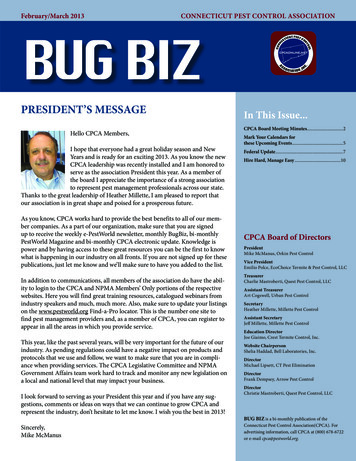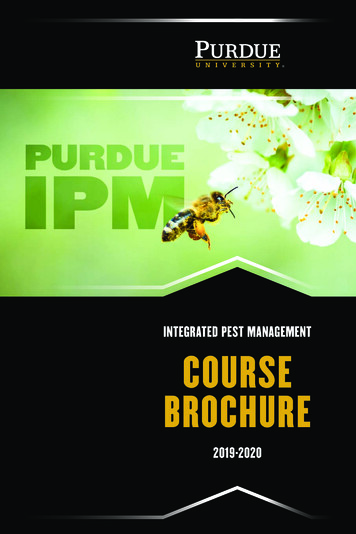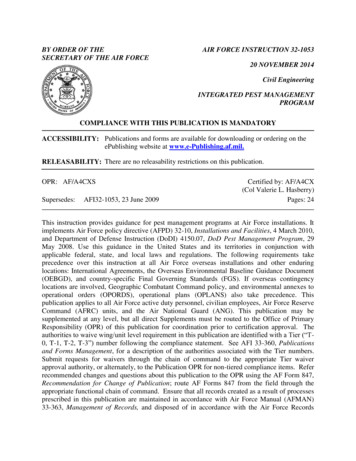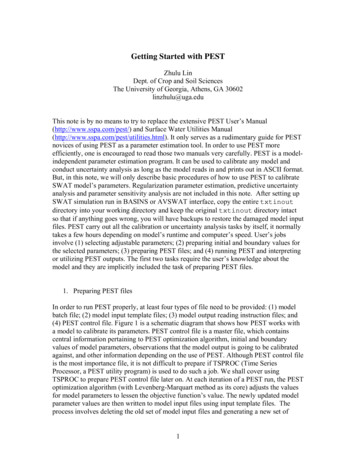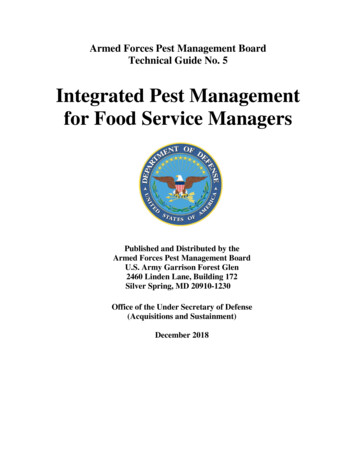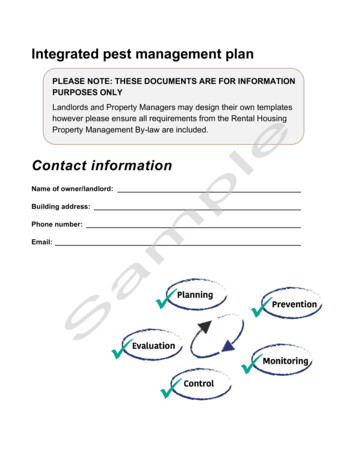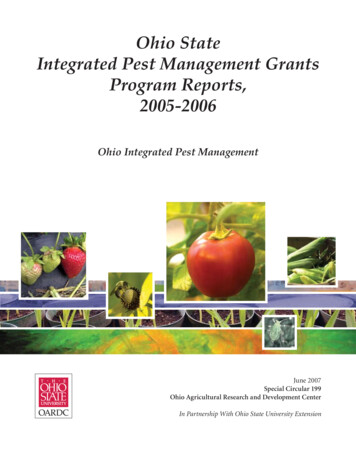
Transcription
Ohio StateIntegrated Pest Management GrantsProgram Reports,2005-2006Ohio Integrated Pest ManagementJune 2007Special Circular 199Ohio Agricultural Research and Development CenterIn Partnership With Ohio State University Extension
Steven A. SlackAssociate Vice President for Agricultural Administration,The Ohio State University College of Food, Agricultural, and Environmental Sciences,and Director, OARDCOhio Agricultural Research and Development Center1680 Madison AvenueWooster, Ohio 44691-4096330-263-3700OARDC embraces human diversity and is committed to ensuring that all its research and related educationalprograms are available to clientele on a nondiscriminatory basis without regard to race, color, age, genderidentity or expression, disability, religion, sexual orientation, national origin, or veteran status.Copyright 2007, The Ohio State University/Ohio Agricultural Research and Development Center.
Ohio StateIntegrated Pest Management GrantsProgram Reports,2005-2006Ohio Integrated Pest ManagementJoseph KovachAssociate Professor and IPM CoordinatorDepartment of EntomologyandAlan SundermeierOhio State University Extension Educator, Wood CountyJune 2007Special Circular 199Ohio Agricultural Research and Development CenterIn Partnership With Ohio State University Extension
AcknowledgmentsThese research and extension projects were conducted with support from the OhioIntegrated Pest Management Program using USDA Smith-Lever 3d funds.EditingJoy Ann Fischer, Communications and TechnologyCover DesignLauren Farr, Communications and TechnologyCover PhotoKen Chamberlin, Communications and TechnologyProduction AssistanceRandy Nemitz, Dave Scardena, Ernie Shannon, Communications and TechnologySalaries and research support were provided by state and federal funds appropriated to the Ohio Agricultural Research andDevelopment Center and Ohio State University Extension of The Ohio State University’s College of Food, Agricultural,and Environmental Sciences. Additional grant support was provided by the organizations and companies listed in theindividual research and Extension reports.The use of trade, firm, or corporation names in this publication is for the information and convenience of the reader.Such use does not constitute an official endorsement or approval by the United States Department of Agriculture, theAgricultural Research Service, The Ohio State University, or the Ohio Agricultural Research and Development Center ofany product or service to the exclusion of others that may be suitable. The Ohio State University/Ohio Agricultural Research and Development Center
Contents2005Introduction7Evaluation of Bio-rational and Natural Products for Vegetable CropManagement in Commercial Market Gardens and Home Gardens9Celeste Welty, Sally Miller, Doug Doohan, Mark Bennett, Matt Kleinhenz,and Bob PrecheurOrganic Thinning Techniques for Apples14Diane Doud MillerSoybean Aphid18Alan SundermeierTolerance of Strawberry Cultivars to Herbicides24Douglas DoohanUse of Trap Crops and Companion Planting to Manage CommonCabbage Pests in Truck Patch Plantings28Ron BeckerUsing Gender Sensitivity in Trapping Oriental Fruit Moth in Peachand Apple Orchards34Ted W. GastierWestern Corn Rootworm Sampling in Soybeans in Ohio38Curtis Young, Ron Hammond, Bruce Eisley, and Greg LaBarge2006Bioassays of Novel Bio-Control Agents for the Control of EconomicallyImportant Tomato Diseases43Brian B. McSpadden Gardener and Sally A. MillerBloom Time Apple Crop Optimization54Diane MillerThe Ohio State University/Ohio Agricultural Research and Development Center
Development and Evaluation of Natural Product Herbicides59John CardinaDon’t Let the Bed Bugs Bite: Conveying IPM Strategies for Bed Bugsin Urban Housing63Susan C. JonesEffect of CO2 Enrichment, Light, and Nutrients on Plant-HerbivorePerformance and Impact on Pest-Management Practices66Luis Cañas, Peter Ling, and Jonathan FrantzEnd-of-Season Weed Control Survey in Soybeans72Greg LaBarge, Mark Loux, Jeff Stachler, Harold Watters, John Yost, Jonah Johnson,Alan Sundermeier, John Hixson, Woody Joslin, Roger Bender, Andy Kleinschmidt,Gary Prill, and Ed LentzHorticulture High Tunnel Workshop, November 14, 200677Matt Kleinhenz, Brad Bergefurd, and Ron BeckerImplementation of Integrated Pest Management in CommercialLawn Care85Parwinder Grewal, John Cardina, Joseph Kovach, David Shetlar, andJoseph RimelspachImproved Apple Pest Management by Codling Moth Granulosis Virusand Modified Timing of Insecticides and Miticides87Celeste WeltyNorth Central Tree Fruit IPM Program92Zachary RinkesOrganic Soybean Insect Pest Research95Alan SundermeierPerennials for Phenology Garden Network Sites99Denise EllsworthStudy the Bioecology of Native Pollinators and Their Associated Habitatin Relationship to Commercial Fruit and Vegetable Production102Roger N. Williams, Roger A. Downer, and Dan S. Fickle The Ohio State University/Ohio Agricultural Research and Development Center
IntroductionThe Ohio State University Integrated Pest Management (IPM) program is acomprehensive program that is designed to encourage collaboration andinnovation among Ohio Agricultural Research and Development Center(OARDC) scientists and Ohio State University Extension (OSUE) personnel tobetter address the pest-management needs of the citizens of Ohio. The goal of theOhio State IPM program is to reduce the environmental, economic, and social riskassociated with managing pests — insects, diseases, or weeds. One way that weaccomplish this goal is to provide funding to Ohio State University collaboratorsthrough an internal IPM grants program to evaluate and disseminate new IPMinformation. This OARDC Special Circular is a collection of reports from thoseprojects that were funded during 2005 and 2006.The Ohio State University IPM grants program funded 21 projects from USDASmith-Lever 3d funds during 2005 and 2006. These projects ranged in size from 1,500 to 10,000 and totaled nearly 114,000. Some 20 reports were submitted thatencompassed all of the basic areas of IPM — monitoring, forecasting, and cultural,biological, and chemical control — on many agriculturally important crops as well ason urban pests.In this special circular you can find reports on monitoring methods of oriental fruitmoth in tree fruit, surveys on the distribution of weeds and aphids in soybeans, beepollinators in fruit, and phenology calendars to improve soil pest forecasting. Reportsthat addressed alternative or organic pest control methods in tree fruit, vegetables,and soybeans are also presented. In addition, reports that addressed pests of concernto urban citizens such as lawn IPM, ornamental gardens, and bed bugs can also befound in this special circular.Some projects reported here are early in their research, such as finding naturalherbicides and measuring the impact of CO2 and light on floriculture pests, whileother projects are ready for implementation. Throughout this publication researchbased IPM information is provided that can be used by all Ohio citizens, whetherthey are conventional or organic farmers or urban residents. It is our feeling thatby having access to these innovative IPM reports, the vast majority of Ohioans willfind pest management methods that are economically efficient, environmentallyresponsible, and socially acceptable.The Ohio State University/Ohio Agricultural Research and Development Center
The Ohio State University/Ohio Agricultural Research and Development Center
Evaluation of Bio-rational and Natural Productsfor Vegetable Crop Managementin Commercial Market Gardens and Home Gardens,2005Investigators:Celeste Welty (entomologist), Sally Miller (plant pathologist),Doug Doohan (weed scientist); andMark Bennett, Matt Kleinhenz, and Bob Precheur (horticulturists)BackgroundThe insect pests and diseases that affectvegetable crops are the same whetherthe crops are grown on large farms forcommercial production or on smalldiversified farms or home gardens, but themanagement tactics preferred by growersare often different for the different scaleoperations. Many market gardeners preferto avoid using conventional pesticidesbecause of concern about human safety andenvironmental contamination.During the past few years, many bio-rationalcrop protection products have becomeavailable. Bio-rational protection productsare derived from a variety of biologicalsources, including bacteria, viruses, fungi,and protozoa, as well as chemical analoguesof naturally occurring biochemicals such aspheromones and insect growth regulators.While it is known that bio-rational productsare safer to humans than conventionalpesticides, it is not known whether they areeffective in controlling the target pests thatthey claim to control.In addition to products for insect and diseasecontrol, many products promote plantgrowth, such as microbial soil inoculants.There is little to no unbiased data availableon the efficacy of these products. This deficitis a limiting factor in formulating up-to-dateExtension recommendations for marketgardens and home gardens.This project was an important first step inthe development of a set of recommendedgarden IPM tactics that will include culturalcontrols to prevent or delay pest problems,along with biological controls and selectivechemical controls.ObjectiveThe objective of this project was to evaluatethe efficacy of bio-rational products that areavailable for vegetable crop managementin comparison with standard conventionalmaterials.MethodsLaboratory bioassays were conducted toevaluate the toxicity of 17 insecticides to 10arthropod pests and two natural enemies.Whole leaves or leaf pieces were treated onboth sides and air dried. Target arthropodsand treated leaves were placed in plasticThe Ohio State University/Ohio Agricultural Research and Development Center
8-ounce deli dishes and held at constanttemperature. Bioassays for beetles, bugs,leafhoppers, and natural enemies wereresidual tests, in which the leaf substratewas treated but the insects themselves werenot directly treated. Bioassays for aphidsand mites were direct plus residual tests, inwhich the pest plus the leaf substrate weretreated. Mortality was evaluated after 24hours in all tests and also after 48 hours formost tests. Damage was rated for chewingpests. Arthropod species tested and detailson size of trials are given in Table 1 for pestsand in Table 2 for natural enemies.Eight field trials were conducted — four oninsecticides, two on foliar fungicides, andtwo on soil inoculants. Details about thescope of the trials are summarized in Table 3.ResultsIn bioassays, differences among insecticidetreatments were significant (P 0.05) for allspecies tested. Products that were most andleast effective for each species are shown inTable 1. A product was considered effectiveif it prevented damage and/or caused highmortality. Products most and least harmfulto natural enemies are listed in Table 2.10The late-season snap bean trial, whichincluded daily sprays during the seedlingstage, showed significant differences amonginsecticides for bean leaf beetle control.Rotenone, pyrethrins, and carbaryl weremost effective; permethrin, azadirachtin,capsaicin, and neem seed oil wereintermediate; and endosulfan, spinosad, andgarlic were least effective.The broccoli insecticide trial showedsignificant differences in damage fromcaterpillars and flea beetles. Permethrin,spinosad, and carbaryl were most effective;pyrethrins, BT, and azadirachtin wereintermediate; and capsaicin and neem seedoil were least effective.Results of the squash vine borer trial wereinconclusive. All treatments producedsimilar results. Results of fungicide efficacytrials are not yet available but will besummarized in a complete report to beposted at the Extension Entomology website.ConclusionValuable information on pesticide efficacywas obtained, information that will bepresented at upcoming Extension programsand in a new bulletin on vegetable pestmanagement.The Ohio State University/Ohio Agricultural Research and Development Center
Table 1. Bioassays Conducted to Evaluate Toxicity of Insecticides Against CommonVegetable Pests, 2005.SpeciesCropand DateTestedTreatmentsReplicatesArthropods perReplicateMostEffectiveProductsInter mediateEffec tiveProductsLeastEffectiveProductsBean leafbeetleSnap bean6/9/05755RotenonePer meth rinCarbarylPyrethrinsCapsaicinGarlicStriped Per meth rinEndo sulfanCarbarylPyrethrinsCapsaicinNeem oilGarlicAza dirach tinPotatoleafhopper,nymphSnap bean7/28/05935Endo sulfanPyrethrinsCarbarylPer meth rinGarlicAza dirach tinCapsaicinNeem PyrethrinsEndo sulfanPer meth rinRotenoneGarlicAza dirach tinNeem Esfen valer ateL-cy haloth rinCarbarylCyfluthrinPyrethrinsEndo sulfanSpinosadPer meth rinSquashbug, youngnymphsZucchini8/27/051155SpinosadCarbarylEndo sulfanPyrethrinsPer meth rinCapsaicinAza dirach tinGarlicNeem oilRotenoneSquash bug,old nymphsZucchini8/31/05753SpinosadEndo sulfanPer meth rinPyrethrinsRotenoneCarbarylSquash bug,adultsZucchini9/19/05953L-cy haloth rinCyfluthrinPyrethrinsEsfen valer ateEndo sulfanSpinosadPer meth rinCarbarylBlister otenonePer meth rinCarbarylEndo sulfanSpinosadNeem oil13310PyrethrinsEndo sulfanOilEsfen valer ateCarbarylSoapPer meth rinAza dirach tinSpinosadCapsaicinGarlicNeem oilMelon aphidPotato aphidTomato10/18/059310Esfen valer atePyrethrinsOilEndo sulfanSoapPer meth rinNeem oilCarbarylTwo-spottedspider miteSnap bean10/26/056330DicofolSoap, OilPyrethrinsPer meth rinThe Ohio State University/Ohio Agricultural Research and Development Center11
Table 2. Bioassays Conducted to Evaluate Toxicity of Insecticides to CommonNatural Enemies, 2005.SpeciesCrop andDate TestedTreatmentsReplicatesArthropods perRepli cateMostHarmfulProductsInter idwasp eem oilEsfen valer atePermethrinBTMulticoloredAsian inCarbarylRotenonePermethrinEsfen valer sulfanGarlicNeem oilSoapSpinosad12The Ohio State University/Ohio Agricultural Research and Development Center
Table 3. Summary of Vegetable Pesticide Efficacy Field Trials Completed, 2005.CropTargetNumberofTreatmentsNumberof y;transplant6/1)Insecticides forsquash vine borer1010Spray 7 times(every 5 days),6/22 to 7/20,or spray 5 times(every 7 days).Harvest yield(18 times; 6/27 to 8/2);pheromone trap for SVB,June to August;scout 3 times for insects;stem dissection after es forpowdery mildew95Spray 5 times(every 10 days),7/22 to 8/29.Harvest yield(22 times; 7/20 to 9/7);foliar disease symptoms 3times (8/16, 8/29, 9/7);scout 3 times for insects.Tomato(mainseason;transplant6/6)Fungicides foranthracnose andearly blight95Spray 6 times(every 10 days),7/21 to 9/8.Harvest yield and quality(7 times; 8/19 to 9/30);foliar disease symptoms 3times (8/16, 8/29, 9/7);scout 5 times for insects.Broccoli(late;transplant7/8)Insecticides forcabbage-worms95Spray 5 times,7/28 to 9/2.Scout 8 times:2 pre-spray and6 post-spray;harvest quality (9/23).Beans(midseason;plant 6/21)Insecticidesfor bean leafbeetle and potatoleafhopper95Spray 4 times:7/23, 7/29, 8/13, 8/21.Scout 7 times:3 times pre- spray and4 times post- spray.Beans(late; plant8/24)Insecticides forbean leaf beetleand spottedcucumber beetle106Spray 4 to 10 times(every 1 to 10 days);different timing foreach of 3 groups ofproductsScout 6 times,all post-spray.Beans(early; plant6/7)Soil fungicides forpythium et al.35Treat onceat seedingStand count 3 timesin first 6 daysafter emergence.Beans(late; plant9/30)Soil fungicides forpythium, etc.66Treat onceat seedingStand count 3 timesin first 10 daysafter emergence.The Ohio State University/Ohio Agricultural Research and Development Center13
Organic Thinning Techniquesfor ApplesInvestigator:Diane Doud MillerDepartment of Horticulture and Crop SciencesIntroductionMethodsEfficiently adjusting apple crop load hasproved to be one of the most difficultaspects of organic production of apples.In normal bloom years, a final set of oneflower per four flower clusters (i.e., 20flowers, as each cluster contains five flowers)ensures good fruit size and adequatereturn bloom. Hormonal thinners, usedby commercial growers, are not allowedin organic production and hand thinningis a time consuming, difficult, boring, anddiscouraging job (If in doubt just try it!).In this first trial of potential organic thinningcompounds in Ohio, compounds wereselected to test based on the followingcriteria — approved organic, availableto homeowners, easily accessible, andinexpensive. Crisco pure soybean vegetableoil and Heinz apple-cider vinegar (5 percentacid) were tested. Five treatments wereapplied:While bloom time thinning is somewhatdangerous in Ohio where nighttimetemperatures during bloom will often resultin frost killing of blossoms, it seems thatblossom thinning is the only way to reducecropping by spraying approved organiccompounds. Frost killing of blossoms is anunreliable way to reduce cropping. The firstblossoms to open (king blossoms) are mostsusceptible to frost, and these blossomsresult in the highest quality fruit and needto be conserved in any blossom-thinningstrategy.2. Full-strength vegetable oil — pinkflagging.141. No thinning treatment (control) — limeflagging.3. Tank mix 1:1 full-strength vinegar: fullstrength vegetable oil — orange flagging.4. Full-strength vinegar — pink/blackflagging.5. Full-strength vinegar followed by fullstrength vegetable oil — orange/whiteflagging.Treatments were applied at the beginningof petal fall. This was considered to be thetime when (from a homeowner’s standpoint)the enjoyment of the bloom was decliningThe Ohio State University/Ohio Agricultural Research and Development Center
as the petals were beginning to brown andfall. Many petals fell off when the trees weresprayed. During the 2005 season, full bloomwas May 5, and treatments were appliedMay 11.Two high value, disease-resistant applevarieties were treated — ‘Goldrush’ and‘Honeycrisp’. ‘Goldrush’ was at late fullbloom-petal fall stage when sprayed, and‘Honeycrisp’ was at late full bloom (roughlytwo days behind ‘Goldrush’). Sprays wereapplied from 10:30 a.m. to 12:30 p.m. on aclear day with 80ºF temperatures and nowind. A backpack sprayer was used withan application rate of approximately 2gallons of oil per 10 trees and 2 to 3 gallonsof vinegar per 10 trees (to drip). The oil wasdifficult to apply in a fine spray. The vinegarwas applied in a fine mist.The trees used were located at HorticultureUnit 2 of The Ohio State University’s OhioAgricultural Research and DevelopmentCenter (OARDC) in Wooster, Ohio. Treeswere six-years-old on B9 rootstock.Experimental trees were selected at bloomtime, utilizing trees displaying uniformbloom volume.The experiment was arranged as arandomized complete block with five treesper block and five replications (25 treestotal per variety). Roughly 100 flowers pertree were counted and fruit set recordedby counting apples on tagged branches atharvest.For ‘Goldrush’, at harvest, fruit set wasdetermined, total number of fruit pertree were counted, total fruit weight wasdetermined, and fruit finish was assessed.For ‘Honeycrisp’, only fruit set wasdetermined as these trees were greatly overthinned by each treatment.Results with GoldrushData are presented in Table 1.Here are the responses by treatment:No ThinningUn-thinned trees over-fruited with small,poor-quality fruit. It is unlikely these treeswill flower next year.Full-Strength Vegetable OilThis basically removed all fruit and routinelykilled the fruiting spurs.Tank Mix 1:1 Full-Strength Vinegar: FullStrength Vegetable OilThis treatment was variable but gives thehint that reduced concentrations of bothoil and vinegar may moderate the harshthinning/tree damage seen by the oil at fullstrength and the probable over-thinning seenwith the vinegar. This treatment suggestsreduced rates will result in reduced thinningand should be followed up with futureresearch.Full Strength VinegarThis treatment gave very interesting results.It thinned too much BUT really improvedthe size and the appearance of the ‘Goldrush’(excluding the russeting response! Russetingis a skin roughening.). Definitely thispreliminary experiment should be followedby a rate-and-timing experiment. Thebackyard and organic aspect of this is veryexciting.Full-Strength Vinegar Followed By FullStrength OilDon’t do it. This researcher almost killedthese trees.The Ohio State University/Ohio Agricultural Research and Development Center15
Table 1. Response of ‘Goldrush’ Apple Trees to Various Organic Thinning Treatments.% SetTreatmentRep 1Rep 2Rep 3Rep 4Rep 5No thinning6430637146Full strength vegetable oil018011Tank mix 1;1 vinegar,vegetable oil52895129Vinegar422965944Vinegar followed by oil01221Mean Fruit Weight (g)No thinning130130150130130Full strength vegetable oil200160180160220Tank mix 1;1 vinegar,vegetable oil220170170100190Vinegar220220240190210Vinegar followed by oil100200100150200Yield/Tree (kg)No thinning3243.957.736.442.5Full strength vegetable oil0.28.35.32.94.6Tank mix 1;1 vinegar,vegetable oil33392016.67.9Vinegar31.62025.17.734.9Vinegar followed by oil0.50.20.30.33.416The Ohio State University/Ohio Agricultural Research and Development Center
DiscussionGoldrush‘Goldrush’ is a variety that is difficult tothin; it over-fruits and stunts tree growth.‘Goldrush’ has great potential as a Midwestorganically grown variety, however, due togenetic scab-resistance and overall fitness.Untended fruit do tend to show sooty blotch,a fungal disease caused by Gloeodes pomigena.Subsequent to selecting vinegar as atreatment this researcher learned of researchevaluating vinegar as an organic herbicide(Rafiq Islam, Ohio State University SouthCenters at Piketon). The immediate effectthat was seen with vinegar was a browningof the leaves — a herbicide effect. Therewas no immediate visible effect of the oiltreatment beyond shining up the leaves.Vinegar over-thinned this variety and isdefinitely worth investigating in lowerconcentrations in future years! Whetherlower vinegar concentrations will give aresponse or not needs to be determined.However, four weeks later the effects werequite different with black, dead, fruitingspurs on any oil-treated trees and basicallycomplete removal of fruit. The vinegartreated trees had either re-greened orcompletely re-leafed with considerable fruitthinning response.There was some russeting of ‘Goldrush’probably due to the caustic acidic nature ofthe vinegar, but this was at an acceptablelevel (less than 10%) from a homeowner’sstandpoint. The increase in fruit size andoverall fruit appearance was remarkable.‘Goldrush’ is a variety that probably needs tobe over-thinned to achieve better appearanceand size.Any further experimentation with oil needsto be at a greatly reduced concentration. Purevegetable oil at various concentrations alsoneeds to be compared to Crocker’s fish oilfor effectiveness. Certainly, Crisco vegetableoil smells a whole lot better than Crocker’sfish oil!One aspect of this research that maybe valuable is that in many sidewalk,homeowner situations, it is desirableto remove all fruit — but there are nocommercial hormonal compounds labeled.This research suggests modifying either oilor vinegar concentrations may give complete(or almost complete) fruit removal withminimal tree damage or environmentalimpact. Certainly this aspect should befollowed up with further research.HoneycrispHoneycrisp is easily over thinned onyoung trees and in this particular year, onthese trees, no thinning was required. Alltreatments greatly over thinned Honeycrispand made further evaluation of yield andquality irrelevant. As these trees age, athinning protocol will be required, however.The Ohio State University/Ohio Agricultural Research and Development Center17
Soybean AphidInvestigator:Alan Sundermeier, Wood County Extension EducatorIntroductionThis project focused on quantifyingthe distribution of soybean aphid innorthwestern Ohio during the 2005 growingseason. A better understanding of soybeanaphid reproduction ability and spread willimprove pesticide application timing. Also,a speed sampling technique was tested foraccuracy.MethodsScouting was conducted in the followingcounties — Wood, Henry, Fulton, VanWert,Crawford, and Allen. Several fields in eachcounty were scouted weekly from the firstsigns of aphids until pesticide spraying. Atotal of 49 fields were used to collect data.Up to 20 sites were selected in each field,and these sites were GPS located wheneverpossible. Observations were gathered fromthat specific site each week. In this way, fieldvariation was overcome by tracking an exactsite’s aphid changes over time.ResultsAs predicted, soybean aphids were awidespread problem in the summer of 2005,with every participating county reportingabove-threshold levels by August.counties of Wood, Fulton, and Henryreporting initial soybean aphid countsduring the week of June 27. Crawford andVan Wert Counties did not report initialcounts until the week of July 18 or later. Ittook about three weeks for a site to increasefrom just a handful of aphids per plant toan over-threshold level of 250 aphids perplant. The period of July 25 to August 7saw a majority of northwestern Ohio fieldsapplying pesticide control for soybeanaphids.Distribution of soybean aphids withinan individual field site did not varysignificantly. The speed sampling techniquedeveloped by the University of Minnesotawas tested and proved to be a good model.More details on this sampling technique areavailable from the University of Minnesotaweb site at: id sampling.htm.When every soybean plant counted had atleast 40 or more aphids per plant, thresholdlevels were reached, and a pesticideapplication was needed. This technique willsave time for scouting and still accuratelypredict treatment needs.Movement spread from the northern18The Ohio State University/Ohio Agricultural Research and Development Center
ConclusionBecause of the variation of infestationtiming in the area, there will continue to bea need to gather localized aphid populationdata to accurately determine if a pesticideapplication is needed. Weekly observationsare needed once an initial infestation hasbeen detected. Speed sampling scouting maybe used to allow a rapid assessment of a siteto determine threshold levels.This project was the first attempt to gatherwidespread, accurate soybean aphidpopulation data in northwestern Ohio.The project should be repeated for severalyears to determine if weather, naturalpredator levels, or other factors have anyeffect on soybean aphid reproduction anddistribution.The Ohio State University/Ohio Agricultural Research and Development Center19
20The Ohio State University/Ohio Agricultural Research and Development Center
The Ohio State University/Ohio Agricultural Research and Development Center21
22The Ohio State University/Ohio Agricultural Research and Development Center
The Ohio State University/Ohio Agricultural Research and Development Center23
Tolerance of Strawberry Cultivars to HerbicidesInvestigator:Douglas Doohan, Assistant ProfessorOhio Agricultural Research and Development Center, Horticulture and Crop ScienceIntroductionStrawberry is sensitive to most herbicides,and certain varieties may even be injuredby labeled rates of herbicides registeredfor the crop. Certain older varieties, like‘Kent’ and ‘Honeoye,’ were considered tobe very sensitive to Sinbar, commonly usedto control weeds in strawberry, while otherssuch as ‘Veestar’ were considered relativelytolerant.Sinbar is the principal herbicide used instrawberry grown in matted rows; thus, asnew varieties become available, there is agreat interest in their respective toleranceto this herbicide. The objective of thisresearch was to characterize the response ofstrawberry cultivars to the herbicide Sinbarand also to the very recently registeredherbicide Spartan.MethodsFour field studies were established in2005 — three trials at The Ohio StateUniversity’s Ohio Agricultural Researchand Development Center (OARDC) inWooster, Ohio, and a fourth on Polter BerryFarms in Fremont, Ohio. The trial at PolterBerry Farms was abandoned in summer2005 when it became clear that the impactof the residual effect of herbicides used24on a previous crop was confounded witheffects of Sinbar. An additional study sitewas established at the OARDC ResearchStation at Fremont in May 2006 (data willbe provided to the Ohio State UniversityExtension IPM program in 2007).Two of the Wooster trials and both Fremonttrials were intended to evaluate varietalresponse to Sinbar. The third Wooster trialwas to evaluate variety tolerance to Spartan.Multiple sites were required for the Sinbartrials because of a suspected interaction withsoil particle size and organic matter (OM)(see Table 1).Strawberry tolerance to Spartan herbicide isknown to decrease when soil pH is greaterthan 6.5 (Figueroa et al., 2005); therefore, theSpartan trial was established on a site wheresoil pH had been elevated to pH 7 by limingin 2003 and 2004.Dormant strawberry plants weretransplanted in each site in early May 2005(2006 at Fremont) and were maintainedfollowing practices recommended byOhio State University Extension (OSUE).Weeds were controlled by cultivation andhand-weeding as needed to control thosethat tolerated herbicide applications. Theexperimental design was a randomizedcomplete block with a split-pl
he Ohio State University Integrated Pest Management (IPM) program is a comprehensive program that is designed to encourage collaboration and innovation among Ohio Agricultural Research and Development Center (OARDC) scientists and Ohio State University Extension (OSUE) personnel to better address the pest-management needs of the citizens of Ohio.
